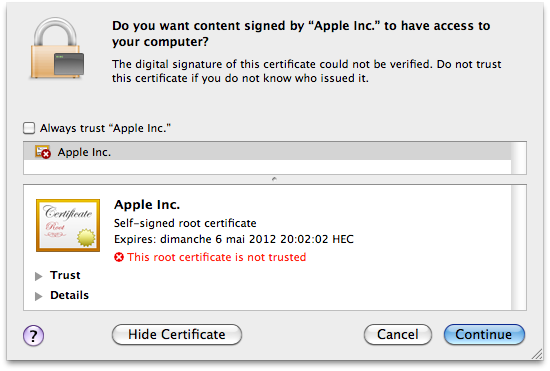Flashback Mac Trojan Horse Infections Increasing with New Variant
Posted on
by
Peter James
We recently reported about a new variant of the Flashback Trojan horse which is using novel techniques to infect Macs. Since then, we have discovered a number of samples of this latest variant, Flashback.G, and have seen evidence that many Mac users have been infected by this malware.
How this malware infects Macs
This new variant of the Flashback Trojan horse uses three methods to infect Macs. The malware first tries to install itself using one of two Java vulnerabilities. If this is successful, users will be infected with no intervention. If these vulnerabilities are not available – if the Macs have Java up to date – then it attempts a third method of installation, trying to fool users through a social engineering trick. The applet displays a self-signed certificate, claiming to be issued by Apple. Most users won’t understand what this means, and click on Continue to allow the installation to continue.

It is worth noting that Flashback.G will not install if VirusBarrier X6 is present, or if a number of other security programs are installed on the Mac in question. It does this to avoid detection. It seems that the malware writers feel it is best to avoid Macs where the malware might be detected, and focus on the many that aren’t protected.
Flashback.G injects code into web browsers and other applications that access a network, and in many cases causes them to crash. It installs itself in an invisible file in the /Users/Shared folder, and this file can bear many names, but with a .so extension. Here are some examples of users posting logs on forums about certain applications crashing. In each case, a file in /Users/Shared is present:
http://community.skype.com/t5/Mac/cant-open-skype-on-my-macbook/td-p/506175
/Users/Shared/.PCImageEditor.so
https://discussions.apple.com/thread/3755322?start=0&tstart=0
/Users/Shared/.AllXilisoftVideo.so
https://discussions.apple.com/thread/3748919?start=0&tstart=0
/Users/Shared/.memalloc.so
http://community.skype.com/t5/Mac/Skype-quits-unexpectedly-on-start-up-yep-another-one/td-p/508077
/Users/Shared/.DocumentConverterdocPrint.so
http://community.skype.com/t5/Mac/Skype-crashing-as-soon-as-I-try-to-open-it/m-p/492045
https://discussions.apple.com/thread/3727882?start=0&tstart=0
/Users/Shared/.InternetHistoryKiller.so
There is also a file created at:
/Users/Shared/.svcdmp
and a plist file, used to patch applications, at:
~/.MACOSX/environment.plist
And logs are stored at:
~/Library/Logs/vmLog
What this malware does
This malware patches web browsers and network applications essentially to search for user names and passwords. It looks for a number of domains – websites such as Google, Yahoo!, CNN; bank websites; PayPal; and many others. Presumably, the people behind this malware are looking for both user names and passwords that they can immediately exploit – such as for a bank website – as well as others that may be reused on different sites. (Hint: don’t use the same password for all websites!)
One of the clues that a Mac is infected is that certain applications will crash. This is notably the case for web browsers, such as Safari, or other network programs, such as Skype. This is because the injected code interferes with the program making it unstable.
This malware also has an automatic update module that checks a number of websites for new versions.
Means of protection
Most of the cases of infection we are seeing are on Macs running OS X 10.6 Snow Leopard. As we reported in our previous post, OS X Lion does not come with Java pre-installed, but Snow Leopard does. It is therefore essential that anyone running OS X 10.6 update Java immediately. To do this, run Software Update, from the Apple menu; if you do not have the latest version of Java, an update will be available.
Nevertheless, many Macs are getting infected by the social engineering trick of the bogus certificate purporting to be signed by Apple, as shown in our screenshot above. If you see this, don’t trust it, and cancel the process.
Intego VirusBarrier X6 detects Flashback.G and all other variants of this Trojan horse. In this case, the mere presence of VirusBarrier X6 causes the malware’s installer to abort, so even if users do not have VirusBarrier X6’s real-time scanner active, the Trojan will look elsewhere.
This malware is particularly insidious, as users don’t download anything or double-click any file to launch an installer. Be careful if you see the screenshot above, and check to see if you need to update Java.
If you are infected by this malware, look for a Java applet in ~/Library/Caches and send it to [email protected] before deleting it. We’d like to see as many samples as possible.
Update: It is important to note that this version of the Flashback Trojan horse does not present an installer, as previous versions did. If a user visits a web page, and their Java is not up to date, the installation will occur without their intervention. If their Java is up to date, they will only see the certificate alert that we show above: they will never be asked for a password, and won’t have to launch any other software to allow the installation to take place.
While we’re still calling this the Flashback Trojan horse, because the actual malware code is similar to the first version of Flashback, its actions are different. In this case, the initial code that is installed on a Mac then downloads more code from a remote server, and deletes the original. What we see here is an exploit, which installs a downloader, which then downloads a backdoor, which in turn injects code into applications.